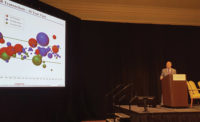
It’s nearly summer and my attention — like that of about 70 million Americans — has turned to gardening! The recent long Memorial Day weekend was my time. Under the auspices of beautiful skies I allowed myself to be distracted for two days by violets, salvia, pansies, coleus, snapdragons — and lots and lots of dirt. My eldest son decided to help this year, convincing me that we should plant a new tree to replace the 90-year-old Elm which had shaded our home for many years but, sadly, was cut down last fall. Planting our small Maple sapling on Memorial Day seemed to be a fitting tribute, in honor of United States military service people.
One might think that Ed Bonifas of Alarm Detection Systems Inc., featured on the cover, has been doing some gardening of a different kind. He is depicted here standing on a lawn full of wireless radio transceivers that appear to be sprouting up from the ground. Of course, this is a conceptual photograph designed to convey the themes of planting/yielding, growth, teamwork and networking. These correspond with the subject matter in our article, “The Changing Face of Alarm Transmission,” which begins on page 48. (And although I enjoyed spending the day outdoors with Ed, our photographer John Geiger, and some of ADS’s technicians — it wasn’t exactly a day at the beach helping to set up more than 40 radios for this photo!)
Alarm Detection Systems and thousands of other security dealers are increasingly turning to wireless transmission products for alarm signaling. Radio-based alarm communication networks such as cellular and mesh are reliable and carry UL listings for fire as well as burglary; they provide dealers with options when consumers discontinue traditional telephone landlines.
There are many types of networks on which dealers can base their alarm communication business. Some networks rely on a unique radio frequency, while others use GSM cellular technology that has widespread geographic coverage. Some systems are point to point, while others — such as Alarm Detection Systems’ — are a mesh configuration in which transceivers act as repeaters for one another. Just as with choosing the right flowers for your garden based on the amount of sunlight, soil type and other factors, choosing the right wireless communication network for your alarm subscribers should be based on the type of customer base and operation that you have.
For example, Alarm Detection Systems, an SDM 100 dealer with more than 27,000 subscribers, is a regional company with a densely populated customer base (see the company’s map of radio transceivers on page 49). Alarm Detection Systems began building its radio network in 1997 with just one subscriber unit (radio), and today it encompasses nearly 7,000 units. The relative closeness of subscribers is what makes the mesh network effective — and the network is owned by the alarm dealer.
“One of the things we like about having our own network is we’re in control of our own destiny,” Bonifas said. “When [cellular carriers] took down the AMPS network, whoever wasn’t changed to GSM was [left out]. In this case we have our own frequency. We are masters of our own domain.”
Call on the providers cited in this article and learn more about which type of alarm communication network is right for your business. As with a flower garden, the initial work of setting up your subscribers on a radio network can be demanding, but the payoff is always worth it.
One might think that Ed Bonifas of Alarm Detection Systems Inc., featured on the cover, has been doing some gardening of a different kind. He is depicted here standing on a lawn full of wireless radio transceivers that appear to be sprouting up from the ground. Of course, this is a conceptual photograph designed to convey the themes of planting/yielding, growth, teamwork and networking. These correspond with the subject matter in our article, “The Changing Face of Alarm Transmission,” which begins on page 48. (And although I enjoyed spending the day outdoors with Ed, our photographer John Geiger, and some of ADS’s technicians — it wasn’t exactly a day at the beach helping to set up more than 40 radios for this photo!)
Alarm Detection Systems and thousands of other security dealers are increasingly turning to wireless transmission products for alarm signaling. Radio-based alarm communication networks such as cellular and mesh are reliable and carry UL listings for fire as well as burglary; they provide dealers with options when consumers discontinue traditional telephone landlines.
There are many types of networks on which dealers can base their alarm communication business. Some networks rely on a unique radio frequency, while others use GSM cellular technology that has widespread geographic coverage. Some systems are point to point, while others — such as Alarm Detection Systems’ — are a mesh configuration in which transceivers act as repeaters for one another. Just as with choosing the right flowers for your garden based on the amount of sunlight, soil type and other factors, choosing the right wireless communication network for your alarm subscribers should be based on the type of customer base and operation that you have.
For example, Alarm Detection Systems, an SDM 100 dealer with more than 27,000 subscribers, is a regional company with a densely populated customer base (see the company’s map of radio transceivers on page 49). Alarm Detection Systems began building its radio network in 1997 with just one subscriber unit (radio), and today it encompasses nearly 7,000 units. The relative closeness of subscribers is what makes the mesh network effective — and the network is owned by the alarm dealer.
“One of the things we like about having our own network is we’re in control of our own destiny,” Bonifas said. “When [cellular carriers] took down the AMPS network, whoever wasn’t changed to GSM was [left out]. In this case we have our own frequency. We are masters of our own domain.”
Call on the providers cited in this article and learn more about which type of alarm communication network is right for your business. As with a flower garden, the initial work of setting up your subscribers on a radio network can be demanding, but the payoff is always worth it.






